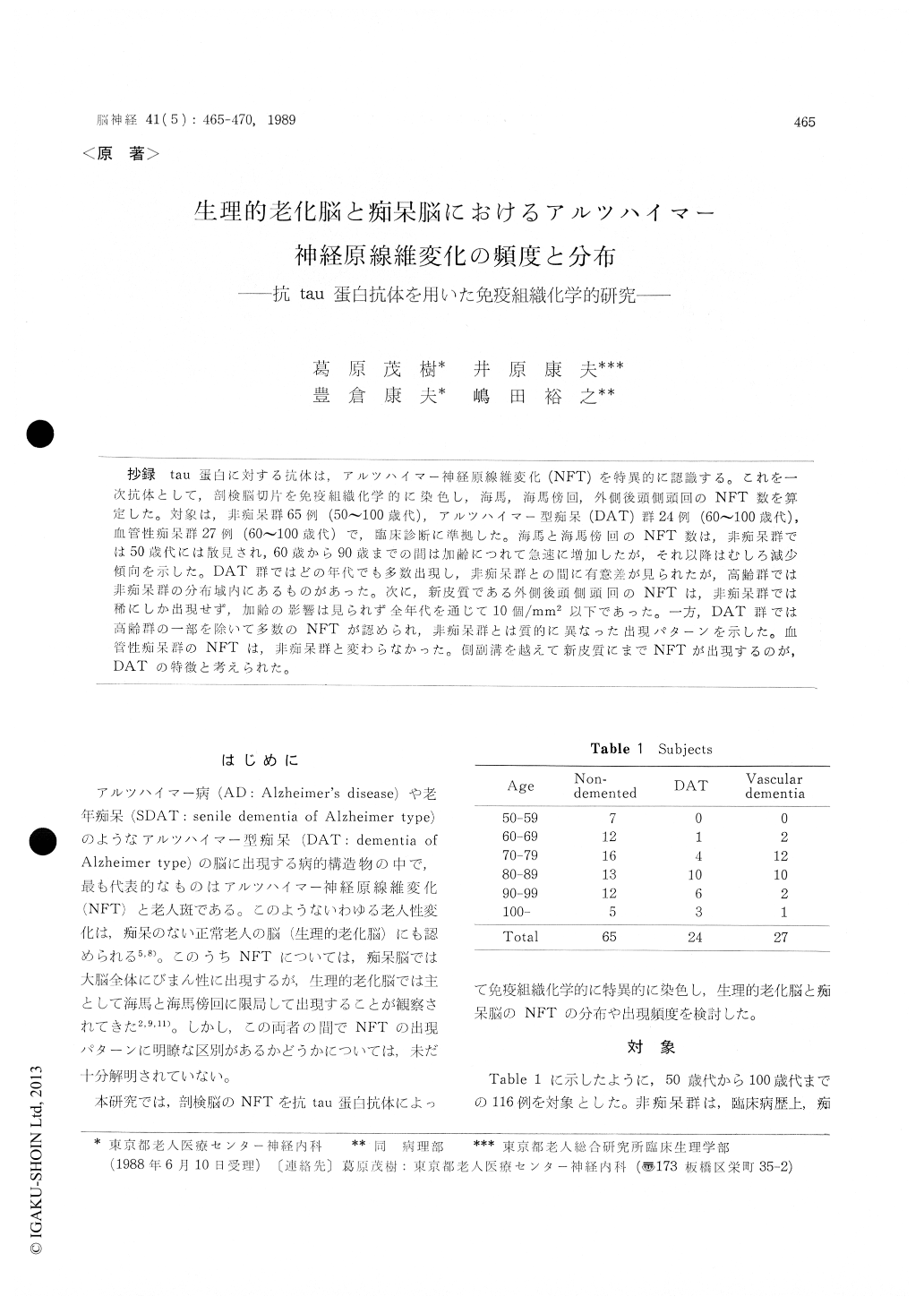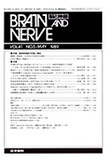Japanese
English
- 有料閲覧
- Abstract 文献概要
- 1ページ目 Look Inside
抄録 tau蛋白に対する抗体は,アルツハイマー神経原線維変化(NFT)を特異的に認識する。これを一次抗体として,剖検脳切片を免疫組織化学的に染色し,海馬,海馬傍回,外側後頭側頭回のNFT数を算定した。対象は,非痴呆群65例(50〜100歳代),アルツハイマー型痴呆(DAT)群24例(60〜100歳代),血管性痴呆群27例(60〜100歳代)で,臨床診断に準拠した。海馬と海馬傍回のNFT数は,非痴呆群では50歳代には散見され,60歳から90歳までの間は加齢につれて急速に増加したが,それ以降はむしろ減少傾向を示した。DAT群ではどの年代でも多数出現し,非痴呆群との間に有意差が見られたが,高齢群では非痴呆群の分布域内にあるものがあった。次に,新皮質である外側後頭側頭回のNFTは,非痴呆群では稀にしか出現せず,加齢の影響は見られず全年代を通じて10個/mm2以下であった。一方,DAT群では高齢群の一部を除いて多数のNFTが認められ,非痴呆群とは質的に異なった出現パターンを示した。血管性痴呆群のNFTは,非痴呆群と変わらなかった。側副溝を越えて新皮質にまでNFTが出現するのが,DATの特徴と考えられた。
Submitted for the study were 116 autopsy brains,from 65 non-demented people, 24 patients with dementia of Alzheimer type (DAT) and 27 patients with vascular dementia, aged between 50 s and 100 s. Formalin-fixed, paraffin-embedded coronal sections of the brains at the level of the lateral geniculate body were immunohistochemically stained with the avidin-biotin-peroxidase complex procedure, using the anti-bodies to tau protein puri-fied from human brains (anti-tau) as the primary antibodies. Alzheimer neurofibrillary tangles (NFTs) which were specifically and selectively stained by anti-tau were semiquantitatively counted in the areas of the hippocampus, parahippocampal gyrus and lateral occipitotemporal gyrus. The re-sults were as follows :
1) In non-demented subjects, NFTs in the hippo-campus and parahippocampal gyrus were scanty in the 50 s : they increased markedly after 60 years until 90 as the patients' age increased ; they tended to decrease over 90 years. In contrast, NFTs in the lateral occipitotemporal gyrus remained none or scanty, always less than 10/mm2 field, throughout the ages between 50 s and 100 s.
2) In DAT cases, NFTs in the hippocampus and parahippocampal gyrus were numerous in all cases at any ages. NFTs in the lateral occipitotemporal gyrus were also many, and always more than 10/ mm2 in all cases except a few ones over 80 years of age. The numbers of NFTs of the three areas were significantly higher in DAT cases than in non-demented subects.
3) In most cases of vascular dementia, the density and distribution pattern of NFTs were essentially similar to those of non-demented subjects. In a few cases, however, they were similar to those of DAT cases.
These findings indicate that in physiological aging of the brain, NFTs affect the hippocampus and the parahippocampal gyrus markedly as one gets older, but never or hardly affect the neocortex throughout life. In contrast, in DAT, NFTs affect not only the hippocampus and the hippocampal gyrus but also the neocortex, at any ages.

Copyright © 1989, Igaku-Shoin Ltd. All rights reserved.


